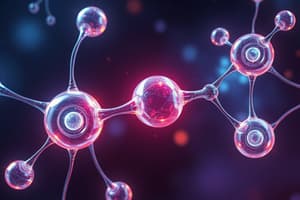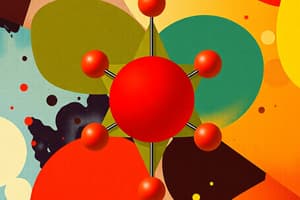Podcast
Questions and Answers
In a trigonal planar molecule, how many atoms are typically present?
In a trigonal planar molecule, how many atoms are typically present?
- 3 atoms
- 4 atoms (correct)
- 5 atoms
- 6 atoms
What angle is formed between atoms in a tetrahedral molecule?
What angle is formed between atoms in a tetrahedral molecule?
- 107 degrees
- 109.5 degrees (correct)
- 104.5 degrees
- 120 degrees
Why might a molecule with polar bonds be overall classified as nonpolar?
Why might a molecule with polar bonds be overall classified as nonpolar?
- The molecule has only nonbonding electron pairs
- The molecule contains only carbon and hydrogen atoms
- The dipoles are symmetrically arranged and cancel each other out (correct)
- The molecule does not possess any lone pairs
What is the bond angle for a V-shaped molecule?
What is the bond angle for a V-shaped molecule?
What shapes can be represented by the general formula AX₃?
What shapes can be represented by the general formula AX₃?
How many bond pairs and lone pairs are there in a V-shaped molecule?
How many bond pairs and lone pairs are there in a V-shaped molecule?
Flashcards are hidden until you start studying
Study Notes
Shape Determination and Electron Pair Repulsion
- Electron pairs around a central atom arrange to maximize distance, influencing molecular shape.
- Strength of repulsion among electron pairs follows the order: Lone pair-lone pair > Lone pair-bond pair > Bond pair-bond pair.
Charge Distribution
- A dipole is a term for a molecule with separated centres of charge.
Molecular Geometry
- A trigonal planar molecule typically consists of four atoms.
- Angles in molecular shapes:
- Tetrahedral: 109.5 degrees
- Pyramidal: 107 degrees
- V-shaped: 104.5 degrees
- Linear: 180 degrees
- Trigonal planar: 120 degrees
Covalent Bonding
- A polar covalent bond occurs when electrons are shared unequally between atoms.
- Polar bonds can result in a nonpolar molecule if dipoles are symmetrically arranged.
Molecular Structures and Bond Pairs
- Pyramidal molecules contain 1 lone pair and 3 bond pairs.
- General shapes based on formulas:
- AX: Linear shape
- AX₂: Linear or V-shaped planar
- AX₃: Trigonal planar or trigonal pyramidal
- AX₄: Tetrahedral shape
Bond Pair and Lone Pair Counts
- Linear molecules can have 1 or 2 bond pairs, depending on the number of atoms.
- V-shaped molecules consist of 2 bond pairs and 2 lone pairs.
- Tetrahedral molecules have 4 bond pairs and 0 lone pairs.
- Trigonal planar molecules are characterized by 3 bond pairs and 0 lone pairs.
Studying That Suits You
Use AI to generate personalized quizzes and flashcards to suit your learning preferences.




